Test review of GLONASS / GPS receivers 2012
An important part of any vehicle monitoring system is navigation receivers. In our equipment since 2005, these were GPS signal receivers, but since 2009, trackers with GLONASS / GPS receivers designed for government orders began to appear gradually in our market.
These GLONASS receivers worked worse and were much more expensive than GPS-analogs. But in recent years, manufacturers of GLONASS chips have released several generations of their products.
New GLONASS chips are increasingly approaching normal GPS receivers in terms of basic performance characteristics: accuracy, sensitivity, launch time, size, power consumption, and even price.
')
Participate in the test review:
Compare yourself:
Fee with GLONASS / GPS receiver GEOS -1M (2011)

Board with GLONASS / GPS receiver Telit SL869 (2012)
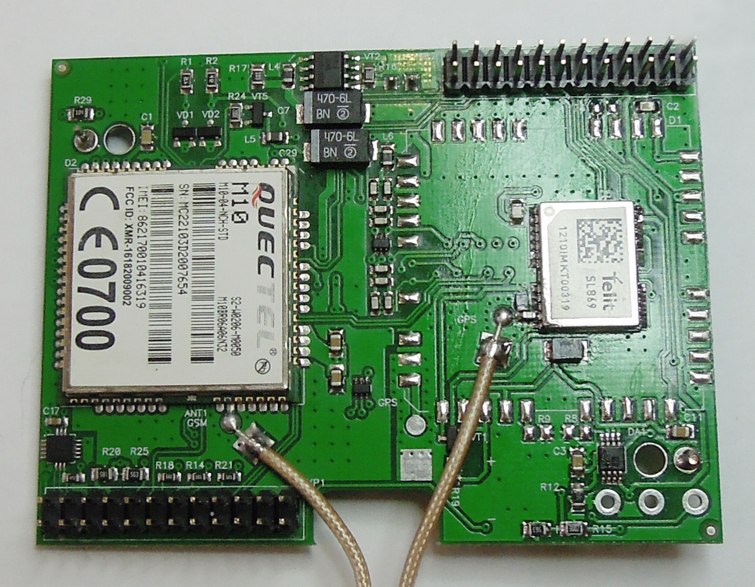
The photo above around the receiver shows the contact pads for the previous generation receiver.
At the beginning of 2012, several manufacturers offered new GLONASS / GPS chips at a price comparable to GPS. Having calculated the savings from the reduction of types of products, it became obvious that it is more profitable to refuse to release GPS trackers, offering it to commercial customers of GLONASS / GPS at the price of a GPS solution. But this would be possible only if the new GLONASS receivers would be equal in quality to the GPS. This was to be found out by our developers in the course of large-scale testing and comparison.
A small digression number 1:
By the number of working satellites, GLONASS has already reached the minimum required number (24 pieces). In addition, the use of two navigation systems at once theoretically makes it possible to increase the probability of determining a position in conditions of a limited sky view. However, our previous experience with various GLONASS / GPS receivers, even in combined mode, spoke about serious playing of “pure” GPS.
Our methodology for testing receivers:
There are very specific indicators of the quality and reliability of solving a navigation problem, such as the average time of a cold and warm start, the standard deviation of the coordinate determination error (in meters) and many more important characteristics. Of course, we look at these characteristics in datasheets, but for 7 years of work in this industry, we have developed the main way to determine the quality of the receiver - the real long-term operation of the monitoring module installed in a real car.
We evaluate this quality very subjectively, carefully looking at the track on the map and trying to find any deviations and strange sections. If they come across even in the run-in mode, questions from customers will be inevitable. Following the results of the comparison, we assigned subjective assessments to each receiver on a ten-point scale.
This is what a normal track looks like (GPS receiver u-blox NEO 6, 2011):
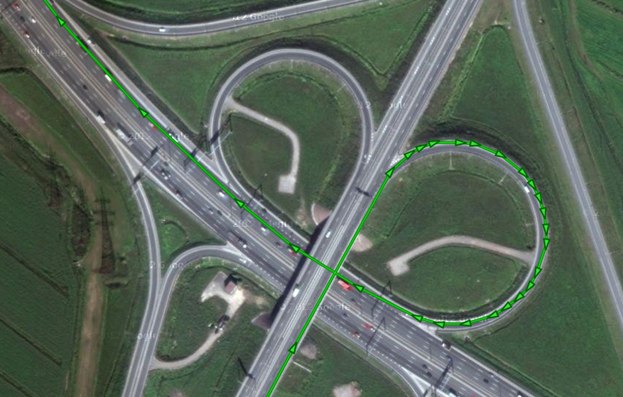
And this is not a normal track (GLONASS / GPS receiver of Izhevsk Radio Plant MNP-M7, 2011):
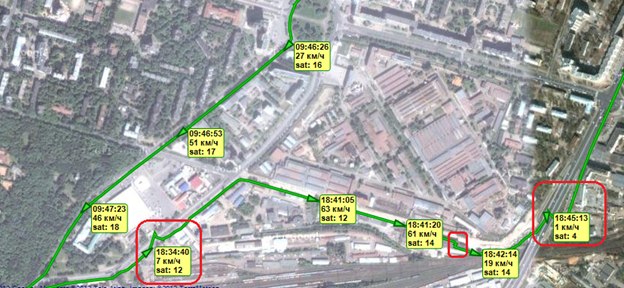
Testing was conducted on personal and corporate cars of five employees for about a week.

From 2 to 6 terminals with different receivers were installed on each car at the same time. GLONASS / GPS antennas were located in the cabin under the same conditions. Power of all terminals was also provided from one point, so that the comparison was as correct as possible. The mileage of each car during the test ranged from 50 to 350 km, while specially selected difficult to navigate places: courtyards, wells, racks, dense urban development.
A small digression number 2:
Almost all the functionality of the navigation receiver and almost all of its characteristics are determined by what processor (or chip) is installed inside it. There are not many manufacturers of GLONASS chips: MTK, Mstar, ST, Qualcomm, U-blox and a number of others, including domestic ones (Navis, IRZ, Geostar Navigation). Technical development in the industry of production of navigation receivers, chips and modules at the moment has reached the point that these chips practically do not require strapping. As a result, practically “any” company can release “its” GLONASS receiver. Enough to have a couple of competent engineers. Finding a contractor who can produce them is also not a problem now. To spoil the results of the chip is also not difficult: if the engineers prove to be insufficiently competent or the manufacturer will save on the external components of the processor's binding (input filter, capacity, etc.). Under these conditions, the choice of a GLONASS receiver is reduced not so much to the choice of a specific solution, as to the choice of a high-quality chip and a reliable manufacturer. For example, Fastrax IT600, Qualcom L16, Telit SL869 and NAVIA GL8088s have a common platform from STMicroelectronics - the STA8088 chip.
These facts were taken into account when selecting applicants and conducting tests.
The start of work (start) for all receivers is sufficiently high quality and fast, there were no discontinuities at start. In a few cases, a small bounce was observed, which was filtered out in the control software.

Once U-blox LEA 6N (one of six) for 1.5 minutes after the start gave the coordinates with an offset of 40 meters (the circled line had to be lower and to the left).
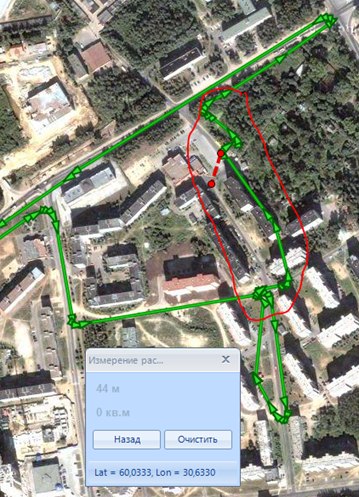
When driving in traffic jams all receivers showed stability. With small and not frequent leads to the side:

In general, all receivers showed a very good track in open areas and in the conditions of movement in the city.
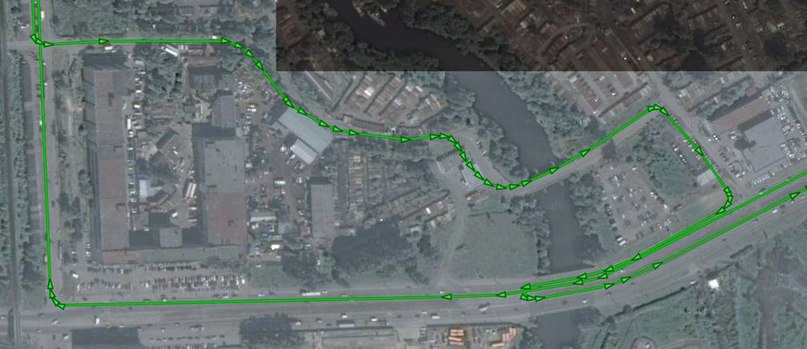
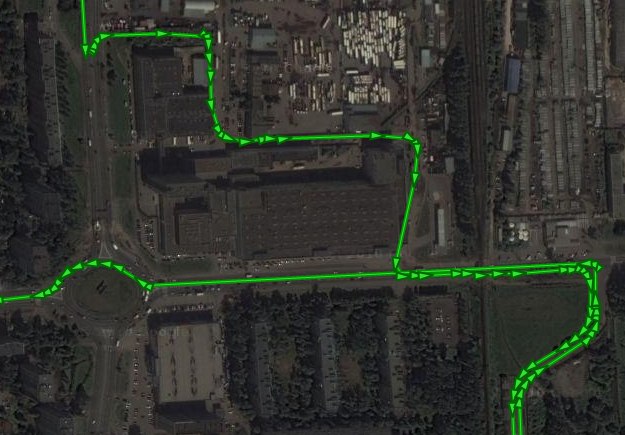
But when working in difficult conditions, the results are already different:



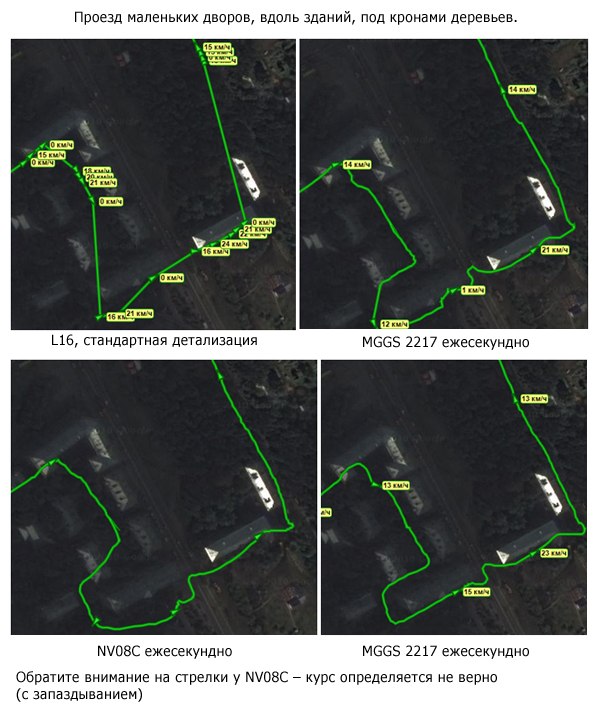
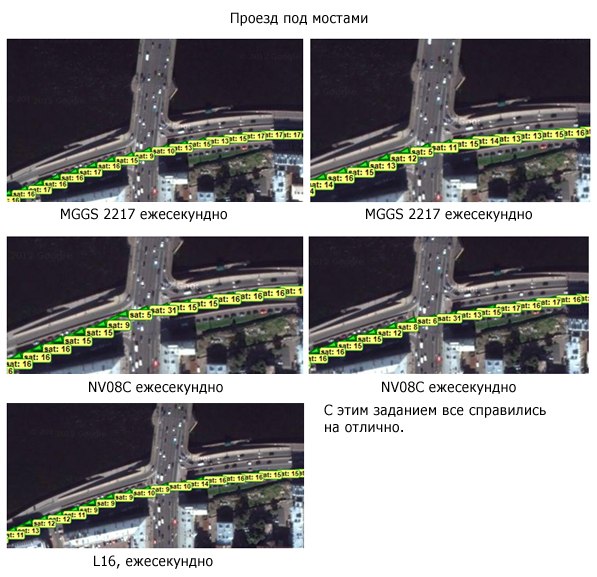



1. Navis as a whole has good tracks, especially when placing the antenna on the roof. Among the shortcomings we can note a certain “delay” of the course and not the best behavior (attributed to the side) in the conditions of the well-yards.
Grade 7
The number of visible satellites on average from 16 to 20.
2. The MGGS2217 tracks are also generally good, better than Navis in the courtyards. Good work out small maneuvers.
Grade 8
Among the shortcomings, we can note the periodic “not receiving” data from the receiver by the terminal - there are no points with every second detailing. The reason is unknown. It is possible in the terminal, and possibly in the diet, since it manifested itself only on one of the cars. The number of visible satellites on average from 15 to 18.
3. For Kviktela L16, the quality of the track is better than that of Navis, but a little worse in drawing complex areas than MGGS2217.
Grade 7
The number of visible satellites on average from 16 to 20.
4. The Telit SL869 receiver is made on the same chip as the L16 and has the same track quality. Grade 7
5. Ublox LEA 6N, despite the fact that it was tested in GLONASS mode, showed the best track. All maneuvers on the road are visible. If it were not for one glitch at the start, there would be a solid nine.
Grade 8
Some examples are:
Course delay on Navis
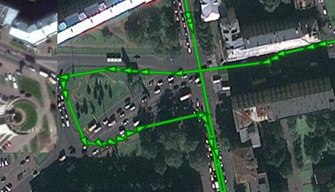


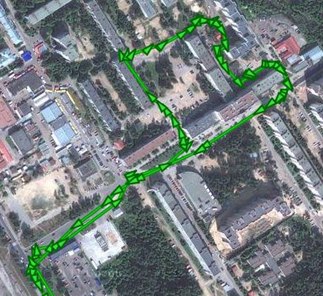
Gaps in MGGS2217 data (every second detail)
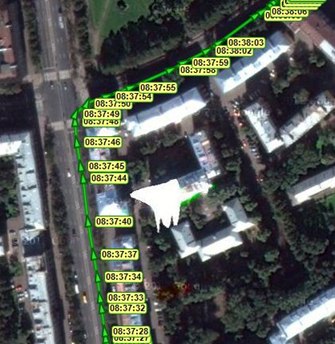


We hope that the presented materials will help dear users of Habr. At the same time, we recall that the review only reflects our test results, and is not the ultimate truth.
These GLONASS receivers worked worse and were much more expensive than GPS-analogs. But in recent years, manufacturers of GLONASS chips have released several generations of their products.
New GLONASS chips are increasingly approaching normal GPS receivers in terms of basic performance characteristics: accuracy, sensitivity, launch time, size, power consumption, and even price.
')
Participate in the test review:
- NAVIS NV08C
- MStar MGGS2217
- Quectel l16
- Telit SL869
- Ublox LEA-6N
Compare yourself:
Fee with GLONASS / GPS receiver GEOS -1M (2011)

Board with GLONASS / GPS receiver Telit SL869 (2012)

The photo above around the receiver shows the contact pads for the previous generation receiver.
At the beginning of 2012, several manufacturers offered new GLONASS / GPS chips at a price comparable to GPS. Having calculated the savings from the reduction of types of products, it became obvious that it is more profitable to refuse to release GPS trackers, offering it to commercial customers of GLONASS / GPS at the price of a GPS solution. But this would be possible only if the new GLONASS receivers would be equal in quality to the GPS. This was to be found out by our developers in the course of large-scale testing and comparison.
A small digression number 1:
By the number of working satellites, GLONASS has already reached the minimum required number (24 pieces). In addition, the use of two navigation systems at once theoretically makes it possible to increase the probability of determining a position in conditions of a limited sky view. However, our previous experience with various GLONASS / GPS receivers, even in combined mode, spoke about serious playing of “pure” GPS.
Our methodology for testing receivers:
There are very specific indicators of the quality and reliability of solving a navigation problem, such as the average time of a cold and warm start, the standard deviation of the coordinate determination error (in meters) and many more important characteristics. Of course, we look at these characteristics in datasheets, but for 7 years of work in this industry, we have developed the main way to determine the quality of the receiver - the real long-term operation of the monitoring module installed in a real car.
We evaluate this quality very subjectively, carefully looking at the track on the map and trying to find any deviations and strange sections. If they come across even in the run-in mode, questions from customers will be inevitable. Following the results of the comparison, we assigned subjective assessments to each receiver on a ten-point scale.
This is what a normal track looks like (GPS receiver u-blox NEO 6, 2011):

And this is not a normal track (GLONASS / GPS receiver of Izhevsk Radio Plant MNP-M7, 2011):

Testing was conducted on personal and corporate cars of five employees for about a week.

From 2 to 6 terminals with different receivers were installed on each car at the same time. GLONASS / GPS antennas were located in the cabin under the same conditions. Power of all terminals was also provided from one point, so that the comparison was as correct as possible. The mileage of each car during the test ranged from 50 to 350 km, while specially selected difficult to navigate places: courtyards, wells, racks, dense urban development.
A small digression number 2:
Almost all the functionality of the navigation receiver and almost all of its characteristics are determined by what processor (or chip) is installed inside it. There are not many manufacturers of GLONASS chips: MTK, Mstar, ST, Qualcomm, U-blox and a number of others, including domestic ones (Navis, IRZ, Geostar Navigation). Technical development in the industry of production of navigation receivers, chips and modules at the moment has reached the point that these chips practically do not require strapping. As a result, practically “any” company can release “its” GLONASS receiver. Enough to have a couple of competent engineers. Finding a contractor who can produce them is also not a problem now. To spoil the results of the chip is also not difficult: if the engineers prove to be insufficiently competent or the manufacturer will save on the external components of the processor's binding (input filter, capacity, etc.). Under these conditions, the choice of a GLONASS receiver is reduced not so much to the choice of a specific solution, as to the choice of a high-quality chip and a reliable manufacturer. For example, Fastrax IT600, Qualcom L16, Telit SL869 and NAVIA GL8088s have a common platform from STMicroelectronics - the STA8088 chip.
These facts were taken into account when selecting applicants and conducting tests.
GLONASS / GPS receivers participating in the test:
NAVIS NV08C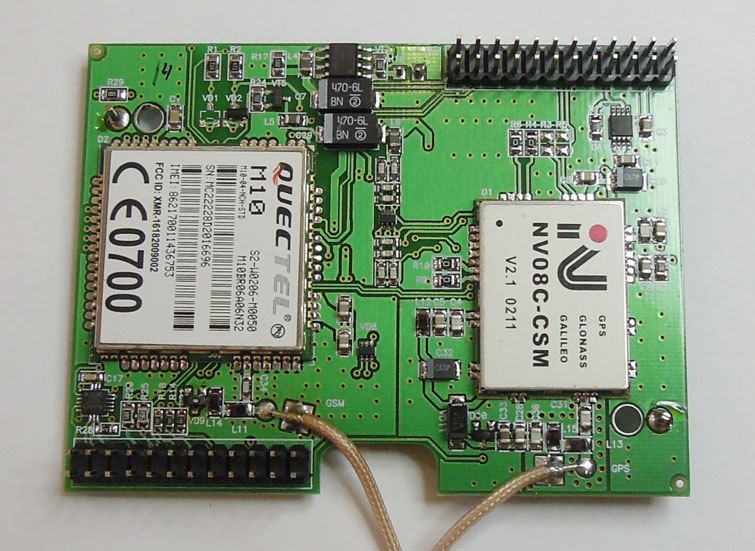 Manufacturer: Russia Number of channels: 32 -160 dBm when tracking -143 dBm at startup Hot start ~ 3s Warm start ~ 25s ~ 25s cold start Consumption: 180 mW with tracking Number of copies in the test: 3 Note: Indicators are indicated for GLONASS / GPS mode |
MStar MGGS2217 Manufacturer: China Number of channels: 20 (80 for search) -161 dBm when tracking -144 dBm at startup Hot start ~ 1s Warm start ~ 32s ~ 34s cold start Consumption: 250 mW at start 215 mW when accompanied Number of copies in the test: 3 |
Quectel l16 Manufacturer: China Number of channels: 32 -162 dBm when tracking -146 dBm at startup Hot start ~ 2,5s Warm start ~ 24s Cold start ~ 35s Consumption: 363 mW at start 314 mW when accompanied Number of copies in the test: 3 |
Telit SL869 Manufacturer: Italy Number of channels: 32 -162 dBm when tracking -146 dBm at startup Hot start ~ 1s Warm start ~ 35s Cold start ~ 35s Consumption: 323 mW at startup 214 mW when accompanied Number of copies in the test: 3 Note: Indicators are indicated for GLONASS / GPS mode |
Ublox LEA-6N Manufacturer: Switzerland Number of channels: 50 -158 dBm when tracking -138 dBm at startup Hot start ~ 2s Warm start ~ 25s Cold start ~ 36s Consumption: 135 mW at start 120 mW with tracking Number of copies in the test: 6 Note: It does not have a combined GLONASS / GPS mode, therefore it was tested in the “GLONASS only” mode and separately from the other participants. |
The start of work (start) for all receivers is sufficiently high quality and fast, there were no discontinuities at start. In a few cases, a small bounce was observed, which was filtered out in the control software.

Once U-blox LEA 6N (one of six) for 1.5 minutes after the start gave the coordinates with an offset of 40 meters (the circled line had to be lower and to the left).

When driving in traffic jams all receivers showed stability. With small and not frequent leads to the side:

In general, all receivers showed a very good track in open areas and in the conditions of movement in the city.
Typical track sections:


But when working in difficult conditions, the results are already different:








Our findings for the receivers:
1. Navis as a whole has good tracks, especially when placing the antenna on the roof. Among the shortcomings we can note a certain “delay” of the course and not the best behavior (attributed to the side) in the conditions of the well-yards.
Grade 7
The number of visible satellites on average from 16 to 20.
2. The MGGS2217 tracks are also generally good, better than Navis in the courtyards. Good work out small maneuvers.
Grade 8
Among the shortcomings, we can note the periodic “not receiving” data from the receiver by the terminal - there are no points with every second detailing. The reason is unknown. It is possible in the terminal, and possibly in the diet, since it manifested itself only on one of the cars. The number of visible satellites on average from 15 to 18.
3. For Kviktela L16, the quality of the track is better than that of Navis, but a little worse in drawing complex areas than MGGS2217.
Grade 7
The number of visible satellites on average from 16 to 20.
4. The Telit SL869 receiver is made on the same chip as the L16 and has the same track quality. Grade 7
5. Ublox LEA 6N, despite the fact that it was tested in GLONASS mode, showed the best track. All maneuvers on the road are visible. If it were not for one glitch at the start, there would be a solid nine.
Grade 8
Some examples are:
Course delay on Navis




Gaps in MGGS2217 data (every second detail)



We hope that the presented materials will help dear users of Habr. At the same time, we recall that the review only reflects our test results, and is not the ultimate truth.
Source: https://habr.com/ru/post/151385/
All Articles